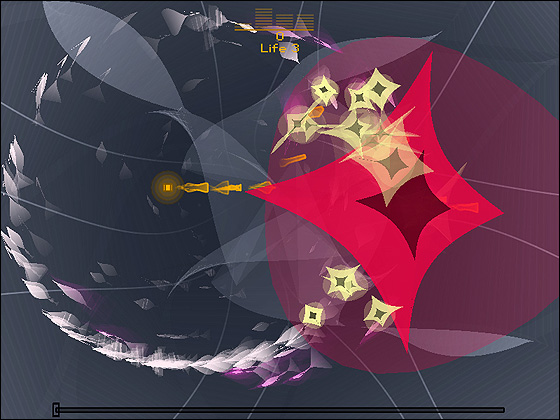Attempting to Understand Everyday Shooter
April 11th, 2010

Everyday Shooter is a game which has touched me profoundly. I can’t believe that I’d be saying such things about an arena shooter, an unassuming, independently-developed one at that. In regards to my former post on games as art, Everyday Shooter excels at bridging the mechanical and contextual while never breaking equilibrium. As someone who despises the pontification of games like Flower in lieu of constructive analysis, I’m going to try my best to provide some sensible commentary on the inner-workings of this title. I’m pretty weary that I’m about to fail though as, despite the fact that I’ve been stewing over Everyday Shooter for the past year that I’ve been playing it, I’m afraid that I still can’t quite wrap my head around what makes it work. It’s really simple, I’m sure but it hasn’t hit me yet, so let’s make a go of it anyways.
General Gameplay
Everyday Shooter is a twin-stick arcade shooter in the vein of Geometry Wars. You use one stick to move your ship, a pixel, and the other to blast threats in any direction. Your movement speed decreases when doing both actions at the same time, facilitating tactical defense and escape strategies.
Inspired by Every Extend Extra, Everyday Shooter employs a combo system whereby destroying certain objects will cause a chain reaction of explosions. The combo system varies from stage to stage. In the first stage (the name escapes me now), explosions from destroying satellite-looking creatures remain on screen for a period of time where the player can temporarily fuel the blast will bullets, any fodder which touch the blast radius add to the combo.
Most enemy types leave a small pellet after they’ve been hit which your ship can collect (pellets have a mild magnetism to your ship) for points. After reaching a certain score, you gain a life and the threshold for the next 1up increases. These pellets can be later used as points to extend the default lives count of your pixel. It is intended that players will have to play the initial levels continually to slowly earn enough points to afford the necessary number lives to crawl their way to the final stages.
Since you’re constantly replaying the same levels to nudge yourself a little further and add credits to the bank for starter lives and an increased chance of breaking into the next stage, one might assume that Everyday Shooter is a repetitive experience, however each stage reacts organically to the player’s success. If you’re scoring well, more enemies will spawn, they’ll spawn additional little factories to spawn more units and flood you. Although the overall template is the same, because you never play two games exactly the same, your experience on each replay differs significantly.
Visual Significance
Each level plays out like an interactive piece of art pertaining a sense of narrative through the patterns of the procedurally-generated shapes. The shapes are sometimes representative of real life objects (birds, bugs, tanks) and sometimes metaphoric. No matter the representation, the shapes act as cogs in the piece’s overall pattern. Although the underlying themes of some levels are more obvious than others, the 8 pieces leave a wide window of interpretation for the player to relate to. Since the designer, Jonathan Mak, is a programmer and not an artist, all of the art in the game is procedurally-generated which contribute to the strikingly natural and organic appearance.

And the Magic…
It’s the thread that ties these two worlds together which is most important. Each level in Everyday Shooter is a dual layered system: a combo and chaining system which corresponds to the visual and aural system. The arena shooter is the interface for you to commandeer the artwork. Your ship is your brush and the bullet fire the ink, so when you play the arena shooter you channel the artwork and the artwork creates a mood which draws you back in to the arena shooter. These two halves have a striking, self-sustained unity. The aural and visual landscapes not only convey information to the read, they’re rich and palatable to the senses, they convey an emotion which the player subsumes and becomes enveloped in. The shooting itself is organic and challenging and the presentation is meaningful and informative so the two halves work together to create a very dense type of game. On completing a round of Everyday Shooter I feel an emotional weight in my chest, and I think that this is how it happens.



 Game Design Companion: A Critical Analysis of Wario Land 4 - $7.99
Game Design Companion: A Critical Analysis of Wario Land 4 - $7.99 Level Design: Processes and Experiences
Level Design: Processes and Experiences Speed Boost: The Hidden Secrets Behind Arcade Racing Design - $5.99
Speed Boost: The Hidden Secrets Behind Arcade Racing Design - $5.99 Adventures in Games Analysis: Volume I - $5.99
Adventures in Games Analysis: Volume I - $5.99







